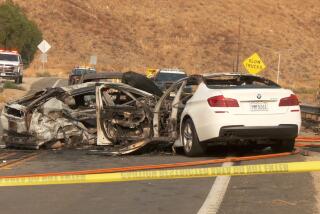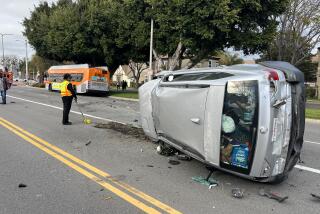Increased use of helicopters eases hospitals’ patient loads
- Share via
A new plan that makes greater use of helicopters to distribute the seriously injured to hospitals across Los Angeles County got high marks Saturday from trauma surgeons who treated victims in the worst mass casualty tragedy since the Northridge earthquake.
Under the plan, victims were airlifted from the Chatsworth crash site to distant emergency rooms, such as at the Ronald Reagan UCLA Medical Center in Westwood, Cedars-Sinai Medical Center near West Hollywood and County-USC Medical Center in Boyle Heights.
Authorities said Saturday that at least 86 of the 135 injured passengers were hospitalized, almost half in critical condition. By comparison, 57 died and 138 were hospitalized in the 1994 Northridge earthquake. In 2005, a Metrolink crash near Glendale killed 11 and sent 140 to the hospital, but the injuries were less grave than in Friday’s crash.
The new plan was developed after reviews of the earlier Metrolink crash and the Santa Monica Farmers’ Market crash in 2003 that left 10 dead, said Cathy Chidester, director of the county’s Emergency Medical Services.
The goal is to ensure that the injured get the proper level of care and to “spread patients out instead of having one hospital inundated” near a disaster scene, Chidester said.
Providence Holy Cross Medical Center in Mission Hills, about eight miles from the site, had prepared for the worst. Notified of the crash by a countywide alert system, the hospital called in additional physicians and nurses. A police escort sped a surgeon to the hospital through rush-hour traffic.
The hospital treated 14 crash victims, five of them critically injured, said Dr. Thomas Waskiewicz, an emergency care physician. The patients suffered head and chest injuries, collapsed lungs, pelvis fractures and broken arms, legs and ribs. “It’s pretty clear people were thrown forward or backward at a high rate of speed,” Waskiewicz said.
Across the Santa Monica Mountains, the newly opened Ronald Reagan UCLA hospital treated eight crash victims, said Dr. Henry Gill Cryer, chief of trauma surgery. Five needed immediate surgery.
The injuries required 50 units of blood, five times more than the 10 units that usually circulate in a typical adult. Patients suffered internal injuries to the spleen, liver and pancreas, and had rib fractures and other broken bones.
“You can imagine, 40 mph, all of a sudden a train stops and the people keep going,” Cryer said.
On Saturday, four UCLA patients were in the intensive care unit in critical condition, and three remained hospitalized in serious condition. One had been treated and released.
Cryer was pleased with how well the hospital, which opened in June, performed. But the county emergency plan, which he called “phenomenal,” gets the real kudos, he said.
Dr. Daniel R. Margulies, trauma director at Cedars-Sinai, echoed the praise. His trauma center treated seven crash victims. Two needed immediate surgery.
Word of the accident came as doctors and nurses were about to change shifts. An order went out immediately for them to stay put. But the distribution of patients went so smoothly that extra help wasn’t needed.
“We could easily have taken more if needed,” Margulies said.
County-USC treated five patients, all suffering major trauma, said hospital spokeswoman Adelaide De La Cerda. One died Saturday. Three remained in critical condition and one in serious condition.
Receiving five severely injured patients at once did not faze the county’s biggest and busiest trauma center.
“It was just another day for us,” De La Cerda said.
Perpetually crowded hospital emergency rooms and a rash of hospital closings have raised fears that the county’s trauma system is so strained that it would not be able to handle disasters as well as it has in years past.
But hospital personnel have always stepped up, Chidester said. What is more worrisome, she said, is the prospect of a long-lasting surge of patients, such as one caused by a flu epidemic, in which hospital personnel would also be affected.
--
rich.connell@latimes.com
Times staff writer Ann M. Simmons contributed to this report.
More to Read
Sign up for Essential California
The most important California stories and recommendations in your inbox every morning.
You may occasionally receive promotional content from the Los Angeles Times.













